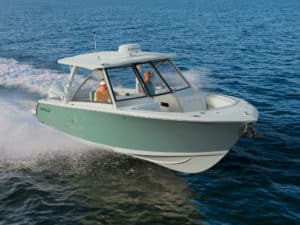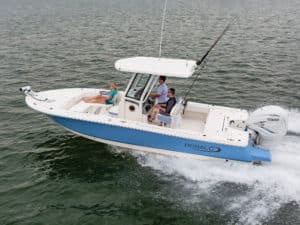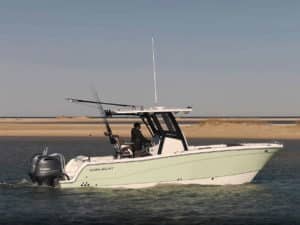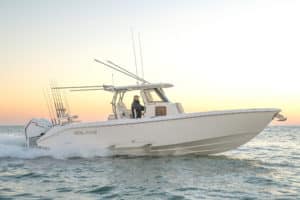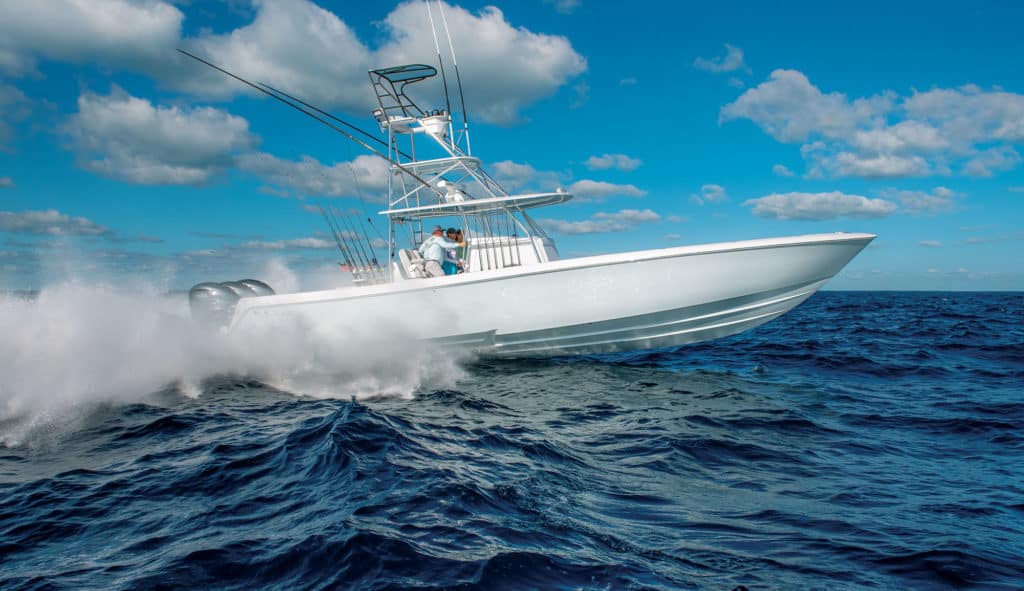
In this age of megasize center-consoles, some boatbuilders have gone beyond sheer size to garner the spotlight, filling the boat with family features such as expanded console cabins, bow loungers, open‑air galleys, mezzanine seating, big-screen TVs in the cockpit, and more.
Contender Boats chose a different tack with its new flagship, the 44 ST. As Sport Fishing’s group publisher Scott Salyers and I stepped aboard the 44 at Crandon Park Marina in Key Biscayne, Florida, we found an expansive, level deck left wide open, clearly dedicated to fishing. Oh, sure, you can customize the 44 ST with lots features, including a second row of helm seating. Yet in its purest form, this boat epitomizes the moniker “fishing machine.”
Welcoming us aboard the company tournament boat, C1, on this early March morning were Contender’s Jordan DeLong and tournament team members Capt. Jon Cooper and first mate Billy Hinckley.
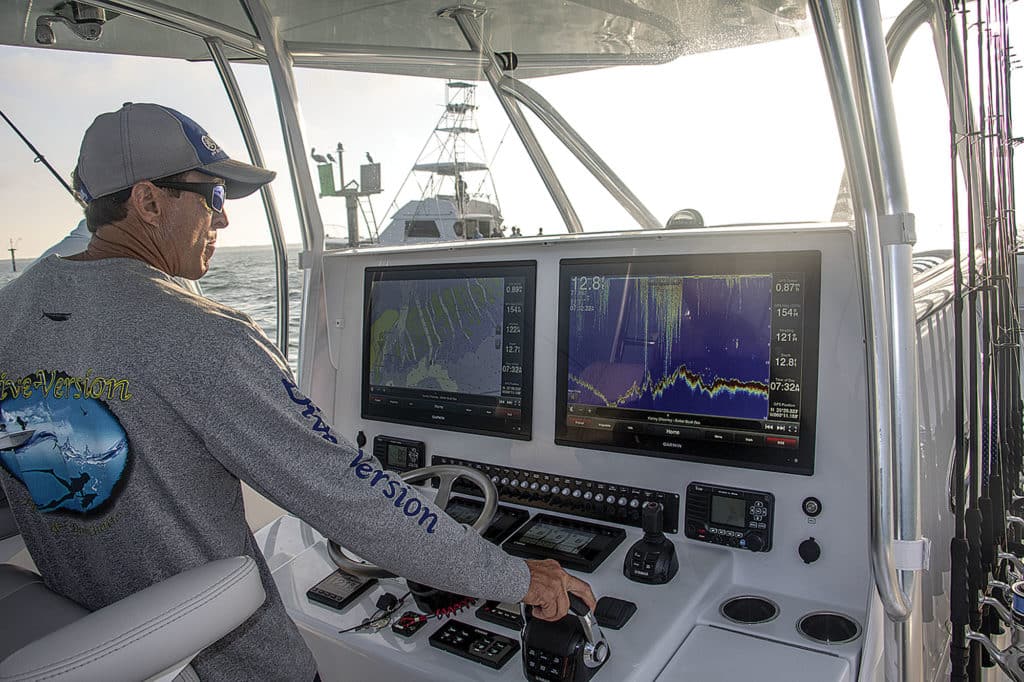
Bait Up Before leaving the dock — and because we planned to target sailfish — we picked up two-dozen goggle-eyes from a local bait vendor and loaded them into the starboard 55-gallon transom livewell. That left the port livewell empty, but not for long.
As we left the marina, a buddy boat called us in to an area in Biscayne Bay that was thick with Spanish sardines and cigar minnows. Cooper throttled up the triple Yamaha 425 XTO outboards, and we quickly arrived. The chirp sonar on one of the twin Garmin GPSMap 8624 displays showed schools of baitfish in 23 feet of water. The 56-inch-wide dash panel was designed specifically to accommodate the width and height of these 24-inch displays.
Four crewmembers began to fill sabiki rigs with wriggling baits. In the process, I got my first glimpse of how easily the aft deck — which measures over 12 feet wide and 8½ feet long — accommodated a group of anglers. Within 15 minutes, the port livewell brimmed with liveys.
The 44 ST also features two deck wells — a 110-gallon tank in the aft deck and a 40-gallon well in the foredeck. Raw-water outlets in the aft quarters allow you to feed portable deck wells too.
Stepping Out Hinckley stowed the bait-catching rods in a deck locker equipped with rod racks on the starboard side of the foredeck, and we were off. I grabbed one of the three-across adjustable Llebroc helm seats as we zoomed out past Cape Florida at 4,200 rpm and 39 mph.
The twin-stepped hull handled marvelously, allowing us to dodge the occasional lobster-pot buoy, while providing a super-smooth ride. A wrap-around polycarbonate windshield protected the helm from wind blast.
We soon arrived at our target depth of 140 feet in purple-blue water at the edge of the Gulf Stream. Cooper turned the bow into the 10 to 12 mph northwest breeze, then ascended the tower with its second station. Hinckley swiftly rigged lines at the prep/tackle station abaft the helm seating, which included an optional rigging tray and 200-quart Frigid Rigid that slides in and out at the press of button.
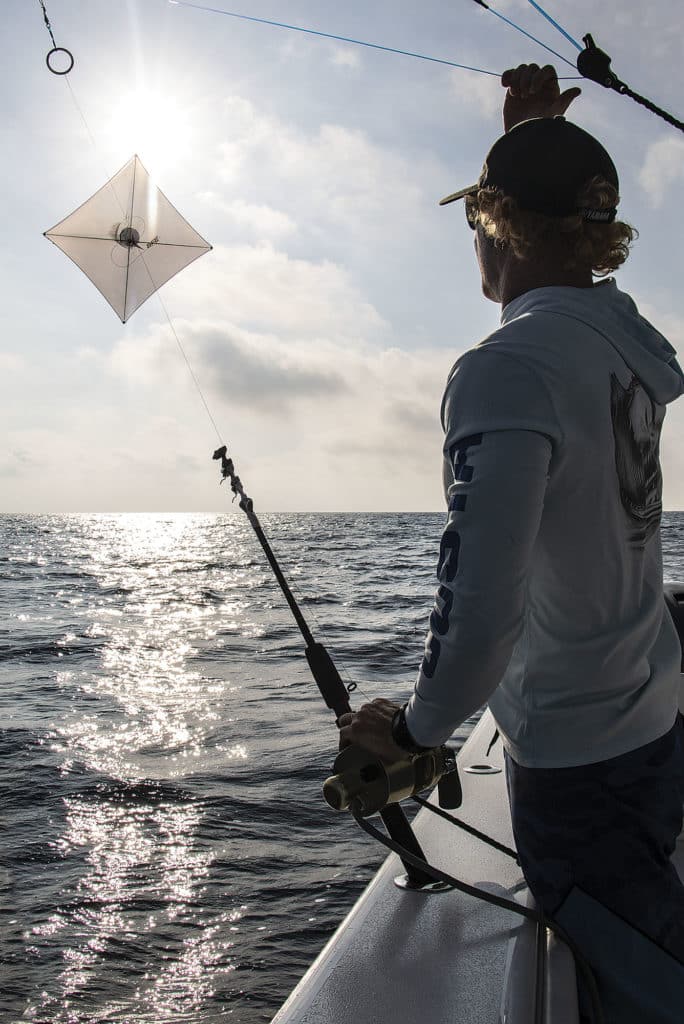
Go Fly a Kite Our 44 ST was equipped with 12-volt power ports on each side, under the coaming pads, for electric kite reels. Hinckley swung out the Lee carbon-fiber outriggers and routed the kite lines through rings in the halyards to create greater separation between the kites. Once we had baits out, Salyers and Hinckley tended lines from a pedestal rocket launcher in the center of the aft cockpit.
In the meantime, DeLong took me on a tour of the bow, which extends 16 feet from the front of the console to the anchor locker and is 10 feet across at its widest point. The C1 is equipped with an above-deck stowage module with an upholstered pad on top. Under the forward portion resides an insulated cooler, and dry-stowage compartments lie on both sides.
We also took a look at the step‑down console interior, accessible via a companionway on the port side. The interior accommodates a flush toilet, vanity and sink, and features teak flooring and 6 feet, 4 inches of headroom.
Sudden Action As we made our way aft, DeLong explained that the 44’s market largely comprises current owners of Contender 39 STs. “There are about 180 Contender 39s out there right now,” he says. “Of course, other boating anglers will buy the 44, but so far, about half of the orders are from owners of the 39.”
Our conversation was cut short around 9:30 a.m. when a sailfish ate one of the bridled kite baits. Salyers picked up the left long line and wound tight to release the line from the clip and secure the circle hook in the corner of the sail’s mouth. A second sail ate the bait on the left short line and DeLong was up. Then a third inhaled the bait on the right long and Hinckley was on. Suddenly, we had a triple hookup with sailfish seemingly jumping everywhere.
While photographing the action, I noted how the wide-open deck allowed the three anglers to battle the fish with nary a tangle. The 28-inch-high gunwales in the stern and bow were the perfect height for this crew. The 31-inch-wide walkways aside the console allowed the anglers to easily follow fish toward the bow. Though one fish pulled the hook, the crew successfully released two.
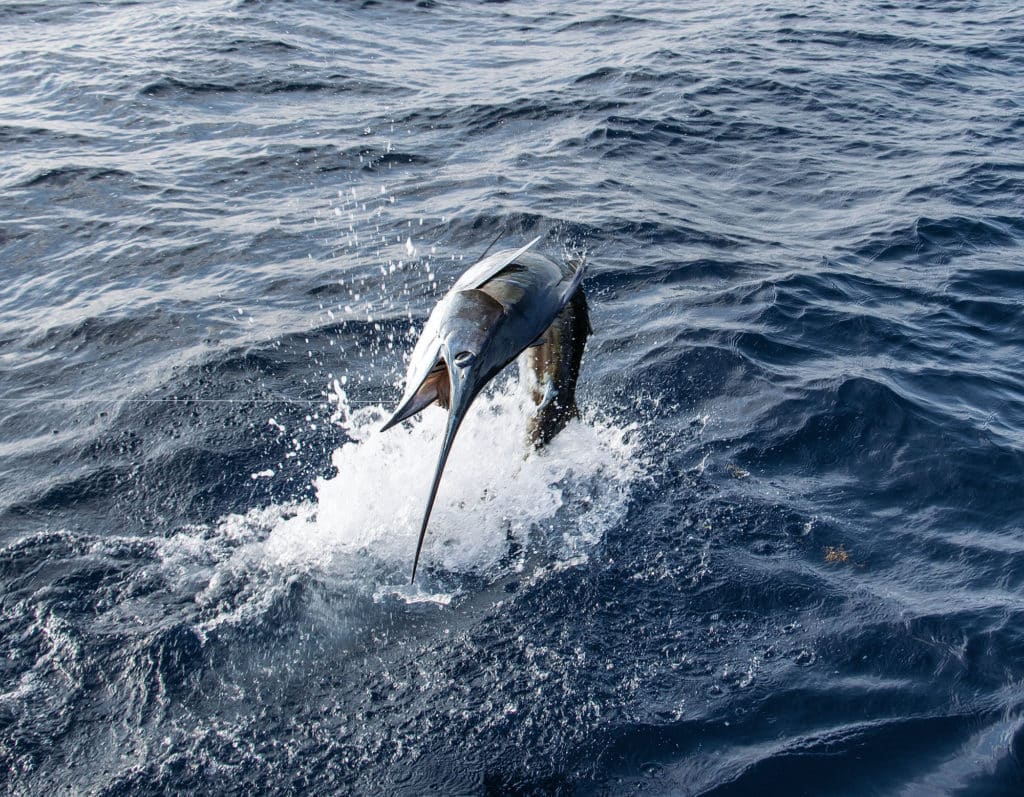
Helium Help As we motored back to the strike zone, the wind began to abate, so Hinckley and Cooper rigged the kites with balloons, using helium tanks stowed in an insole locker under the bow stowage/seating module. A motorized lift lets you tilt up the module to access a cavernous compartment underneath.
Around 10 a.m., nearly as soon as the baits were out, another school of sailfish attacked. This time we had a double. One fish broke off fairly quickly, but DeLong remained hooked up to a tough customer — an 80- to 90-pound sail that fought for more than 20 minutes before Hinckley was able to lean over the gunwale to leader and release the fish.
As if double and triple hookups weren’t enough to test the 44 ST, the next flurry found us with a quadruple hookup on sails. DeLong, Hinckley and Salyers were all busy with a triple when the fourth fish bit, and so I picked up the rod. Two fish came to the boat fairly easily for quick releases, but two sails decided to head in opposite directions. Mine sprinted south from the bow, while Salyers’ charged north from the stern.
Backing Down Cooper decided to chase Salyers’ fish first, reversing so the angler could gather line. With the integral engine bracket, the 44 ST backed down beautifully without taking a drop of water over the full transom or through the scuppers. Soon the fish was within range, allowing Hinckley to leader the sail for a successful release.
Now it was my turn: Good timing since I was nearly out of line. Cooper motored forward, allowing me to put line back on the reel and battle the fish to the boat. The first mate laid on the bow, reached out to grab the leader, and released the fish. We went four for four on that series, and were seven for nine for the morning. Quite a trip, and it wasn’t even noon yet.
Running the Numbers As the afternoon started, the wind died completely. We brought in the lines and headed inshore to gather performance data with a real-life load of 400 gallons of fuel, five adult males, and the 110 gallons of water in the transom livewells. The triple 425 XTOs propelled the 44 ST to 30 mph in 12 seconds. The big Contender posted a top speed of 65 mph at 6,000 rpm, where the outboards burned 109 gallons per hour for 0.6 mpg.
Read Next: Contender 39 Fisharound Review
Best fuel efficiency occurred at 4,000 rpm and 37 mph, where the triple XTOs consumed 46 gph, resulting in 0.8 mpg. That translates to a range in excess of 430 miles, based on 90 percent of the 600-gallon fuel capacity. Of note, the 44 ST is available with quad 425 XTOs, and both the speed and efficiency are improved in that configuration, according to Contender.
If you’re looking to upgrade to a mega-center-console that captures the essence and passion of offshore angling — without a lot of nonfishing add-ons — consider taking a very close look at the Contender 44 ST.
Performance Power: Triple Yamaha 425 XTO outboards Load: 400 gal. fuel, five crew Top Speed: 65 mph @ 6,000 rpm Time to 30 MPH: 12 sec. Best MPG: 0.8 @ 37 mph (4,000 rpm)
Hull LOA: 43 ft. 10 in. Beam: 12 ft. 1 in. Transom Deadrise: 22.7 deg. Dry Weight: 19,600 lb. (ready to fish) Draft: 2 ft. 3 in. Fuel: 600 gal. Max Power: 2,000 hp MSRP: $646,583 (base w/ triple Yamaha 425 XTOs)
Contender Boats Homestead, Florida 800-645-2906 contenderboats.com

